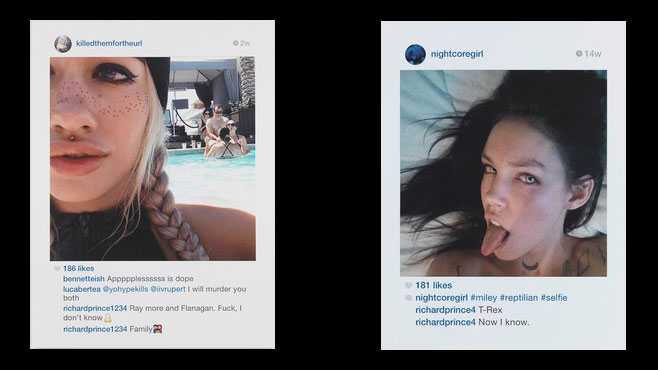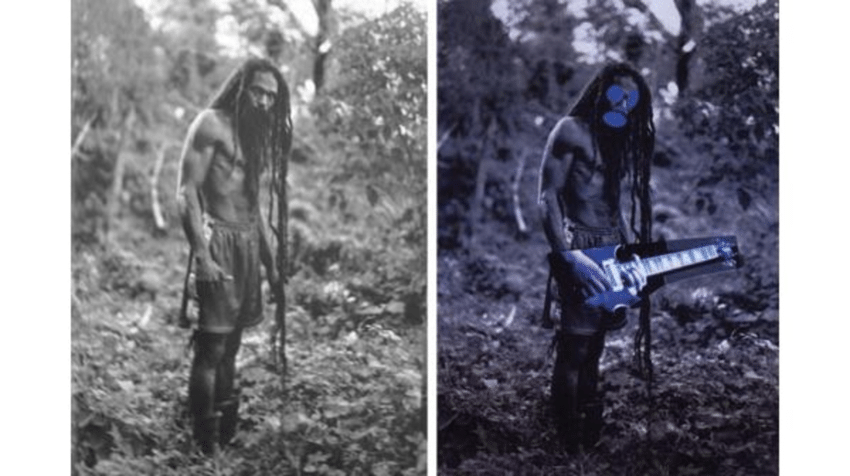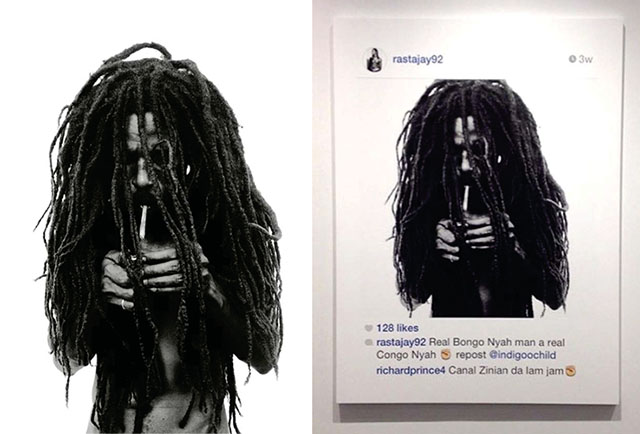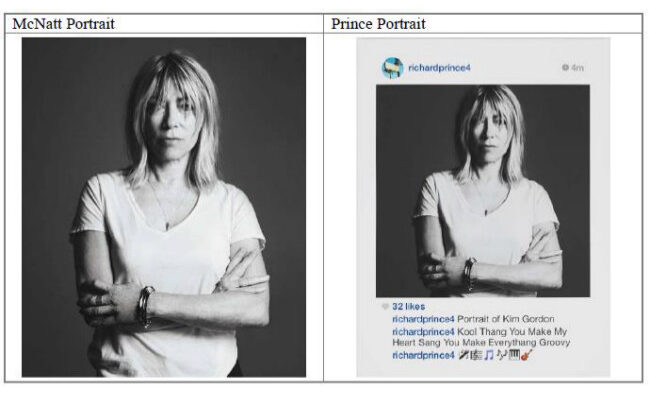US art appropriator, Richard Prince, may have finally met his match in the legal arena after a judge green lit a copyright lawsuit against him over the infamous ‘New Portraits‘ Instagram series.

A New York federal judge refused to throw out two lawsuits filed by photographers, Donald Graham and Eric McNatt, despite Prince requesting dismissal by once again arguing his work is Fair Use, a controversial exception to copyright infringement.
The Graham lawsuit was filed way back in 2015, while McNatt’s was submitted in 2020. It’s unclear why it has taken eight years for the Graham lawsuit to lurch forward towards trial, with few updates available over the intervening years.
Graham and McNatt may be in a better position to win their lawsuits than French photographer, Patrick Cariou, who had 30 images appropriated by Prince. For that series, Prince created childish collages of Cariou’s 2000 ‘Yes, Rasta’ photo series by pasting guitars in the subject’s hands, gas masks on their face, and using an MS Paint-style brush to paint blotches on their faces.

In 2013 a judge found that all but five of the 30 Prince works were ‘transformative’, a crucial component of Fair Use. The landmark ruling offered a liberal interpretation of ‘transformative’, contributing to the erosion of copyright protection for US photographers whose work is appropriated.
Now it emerges that Prince’s ‘New Portraits‘ may not be Fair Use, with US district judge Sidney Stein stating Prince modified the original works ‘without being transformative’.
‘Prince did not use plaintiffs’ photographs as raw material to create a collage or nor did he attempt to obscure the images,’ Stein wrote. ‘A reasonable observer would likely identify Prince’s alterations as (1) adding the Instagram frame and (2) showcasing his own comments. These modifications certainly do not being to approach the alterations found to be transformative as a matter of law in Cariou and Blanch.’
New Portraits, old thievery
For ‘New Portraits‘, Prince printed screenshots of Instagram posts. His modifications of photographers’ pictures amounts to including the Instagram interface as the border, and adding cheeky comments and captions. The prints were displayed at the prestigious Gagosian Gallery in New York, selling for an astounding US$90,000 each.
They sold out! This isn’t necessarily because the art has merit, but is more likely due to Prince’s profile. He’s an untouchable darling of the elite New York arts scene. Anything he hangs on a wall immediately receives high praise from critics, including ‘New Portraits’. New York magazine senior art critic, Jerry Saltz, describes ‘New Portraits‘ as ‘genius trolling’ in a 2014 column for Vulture magazine. Here is his intro paragraph from 2014:
‘What does the internet do? The internet hates. Obviously, it does lots of other things, too — it jump-starts insurrections, appropriates, lusts, scrambles, loves cats, disrupts. But hating often seems like what the internet does best, especially when it’s got a good troll. And it’s done a lot of hating recently in response to Richard Prince’s semi-revolutionary, drop-dead simple, often salacious Instagram paintings. For these works, Prince has been called a dirty old man, creepy, twisted, a pervert. All of which may be true — but true in a great way, if that’s possible.’
Richard Prince enjoys his status, leaning into the outrage by making arrogant or irritating troll-like comments. For instance, in response to Graham’s lawsuit in 2017, Prince posted on Twitter, ‘Phony fraud photographers keep mooching me. Why? I changed the game’.
Saltz’s labels of Prince, from troll to pervert, are likely accurate assertions. Prince appears to only be one-upped in this department by a man he loathes, former US president Donald Trump. When Prince isn’t making audacious claims about ‘changing the game’ on Twitter, he’s complaining about politics with a particular distaste for Trump. Although a compelling argument could be made that Prince is the ‘Trump’ of the art world.
My shrink tells me that people who have portraits of themselves hanging where they live are unhappy, lonely, and scared. And when they die nobody cries, nobody cares. She told me if Trump shot himself on 5th Ave he would miss on purpose. pic.twitter.com/7mzaUxEIS7
— Richard Prince (@RichardPrince4) November 8, 2019
To get more of an idea about how Prince is embraced by sycophant art lovers, here is more from the Vulture article.

Saltz describes Prince’s ‘New Portraits‘ captions – almost the only trace of a ‘modification’ in the series – as ‘truly brilliant’, adding ‘layers on top of the disconcerting images’. The ‘New Portraits‘ print showing Graham’s picture has Prince comment ‘Canal Zinian da lam jam’. ‘Truly brilliant’?
‘Here he is delving as deep as he ever has into privacy, copyright, and appropriation, twisting images so that they actually seem to undergo some sort of sick psychic-artistic transubstantiation where they no longer belong to the original makers.’
Saltz even praises the poor quality of Prince’s screenshots, describing the blurry pixels as relating to ‘the Ben-Day dots of printing and offset technologies of yore. Moreover, Prince’s slices of immaterial digital reality uploaded into physical space and placed in art galleries stretch the membrane thinner between these realms.’
Or maybe the screenshot is a low quality JPEG that falls apart on a five-foot print.
The case against Prince
In Graham’s complaints against Prince, Gagosian Gallery, and Larry Gagosian, he claims the only modifications include ‘minor cropping of the bottom and top portions’ that leaves most of the original image ‘fully intact’, the aforementioned comment, and an Instagram border.
Like Cariou, Graham spent considerable resources capturing his 1996 series, which involved trekking mountains in Jamaica. While he sells the images in print editions, the photographer never licensed the image to Prince or made it available for a commercial purpose. Upon discovering the alleged copyright infringement, he sent cease-and-desist letters to Prince and the Gagosian Gallery, which were ignored.
Graham’s lawsuit highlights Prince’s overall disregard for copyright ownership. In 2014, Prince responded to Graham’s wife via Twitter by posting: ‘You can have your photo back. I don’t want it. You can have all the credit in the world’.
And this comment from 2011: ‘Copyright has never interested me. For most of my life I owned half a stereo so there was no point in suing me, but that’s changed now and it’s interesting…So sometimes it’s better not to be successful and well known and you can get away with much more. I knew what I was stealing 30 years ago but it didn’t matter because no one cared.’

Eric McNatt’s lawsuit against Richard Prince regards his portrait of Sonic Youth bass player, Kim Gordon. Prince added the comment, ‘Kool Thang You Make My Heart Sang You Make Everythang Groovy’, followed by emojis.
Judge Stein wrote that Prince ‘indeed tested the boundary between appropriation art and copyright infringement’, allowing the cases go to trial.
Portrait of Rastajay92 and Portrait of Kim Gordon make several modifications which are ‘both minimal and insufficient to warrant the conclusion that they result in an aesthetic and character different to plaintiffs’ original photographs,’ Judge Stein’s opinion states. ‘Defendants’ attempt to cast the images as satire or parody fails, and Prince’s stated purpose in creating these portraits has been both inconsistent and has only limited relevance in light of the similarities between the original and the secondary works.’
Will Goldsmith’s victory against Warhol impact Prince?
US photographer, Lynn Goldsmith, recently won a landmark copyright lawsuit against the Andy Warhol Foundation, which failed in its appeal to the Supreme Court. While the ruling covered how Warhol ‘transformed’ Goldsmith’s work, the final outcome hinged on the usage.
Both Goldsmith and Warhol works appeared in magazines. They therefore had ‘substantially the same commercial purpose meaning they were essentially in competition with each other’. Read more about it here.
Fair Use is measured by four factors:
– the purpose and character of your use;
– the nature of the copyrighted work;
– the amount and substantiality of the portion taken;
– the effect of the use upon the potential market.
‘It was the licensing use, not the creative use, that was at issue,’ said Michael W. Carroll, professor of law at the American University Washington College to New York Times.
‘It now falls to the lower courts to interpret how broadly to read the opinion,’ he said. ‘Is it really just about competitive licensing use, or is it more broadly about creating derivative works? I think what you’ll see is lower courts reading it each way, and then eventually this issue is going to find its way back to the Supreme Court.’
One of Prince’s lawyers, Brian Sexton, said the Warhol Foundation ‘went to great pains’ to limit the Goldsmith lawsuit to a ‘single licensing dispute’.
‘As Richard Prince makes individual paintings and does not license his works, the holding in Warhol is clearly inapplicable to his New Portraits litigation,’ he told the New York Times.
‘The concern among artists with the Warhol Foundation decision is that some of the regressive fair use language used in reaching this very specific and limited ruling on a commercial license will be applied to individual works of art, and lead to more confusion.’
Given Graham sells prints of his original, he could argue that Prince’s usage competes with his own.
If Graham and McNatt win their copyright claim against Prince – it will be a tough battle – then it may open the floodgates for more photographers to file lawsuits over ‘New Portraits’. This includes Melbourne fashion photographer, Peter Coulson, whose work appearing in ‘New Portraits’ left him feeling ‘violated’ by Prince.
‘My reaction was the same every time I see someone using my image without my permission,’ Coulson said to the Sydney Morning Herald in 2015. ‘If you’ve ever had your house broken into, you know that feeling that you have in your house that you’ve been violated.’





Be First to Comment